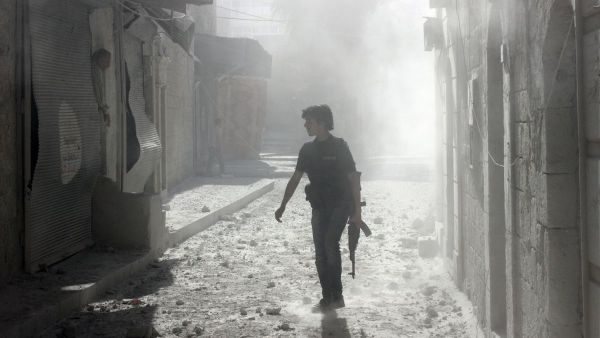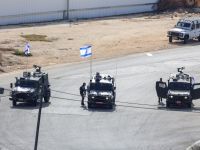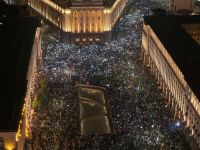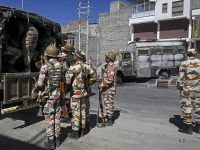- Trump's decision to withdrawal from the Iran nuclear deal has already had military consequences
- Iran fired rockets into Israeli controlled territory while Israel shelled and struck 35 targets in Syria
- Iran and Israel are now headed for a military confrontation neither can stop
- The human costs inside Syria may be severe, worsening an already dire humanitarian situation
By Ty Joplin
In the days and hours leading up to U.S. President Donald Trump’s announcement that the U.S. will withdraw from the Iran nuclear agreement, Israel was preparing for war in the Golan Heights.
Urging all residents in and around the mountainous, border region to prepare bomb shelters, Israeli forces moved in rocket launcher systems capable of striking ground targets with high precision up to 70 km away. Then, mere hours after Trump signed the executive memorandum detailing the U.S. withdrawal, Israel began striking targets inside Syria with jets.
Israel’s Defense Minister Avigdor Lieberman said that Israel does not want to escalate the conflict between Syria and Iran, who have a massive military presence in Syria, but that Israel would not allow Syria to become a "frontline base" for Iran.
The problem here is that Syra already is a frontline base for Iran.
If Israel wants to prevent that, it has no choice than to escalate the conflict, which it has just done. Israel has reportedly struck 35 targets inside Syria after receiving a volley of 20 rockets from Iranian forces near the Golan Heights.
Israel’s targets and military equipment in the Golan Heights suggests it is now preparing for a more drawn out conflict, one that will re-open the southern front in Syria, and potentially exacerbate what is already one of the worst humanitarian crises happening in the world today.
Trump's announcement seems to have been the green light Israel was waiting for to escalate its involvement in Syria.
A War Posture

A map showing where Israeli forces allegedly struck targets inside Syria. The highlighted country is Syria, and many of the targets are in southern Syria and near Damascus. Red dots indicate points Israel targeted (Rami Khoury/Al Bawaba)
On May 7th, the day before Trump’s announcement, Israeli Multiple-Launch Rocket Systems (MLRS) were photographed, reportedly in the Golan Heights. The MLRS system purchased by Israel from Lockheed Martin in 2016 can fire rockets up to 70 km away with a high level of precision. Several Iranian bases and operational centers are within 70 km of the Golan Heights.
The MLRS is not used for anti-air defense, but for volleys of rocket fire onto ground targets, meaning their reported deployment would not be used to intercept Iranian jets or drones.
Around the same time, Israeli authorities urged residents living in and around the Golan Heights to prepare bomb shelters; a word of advice that became prescient. Early on the morning of May 10th, a volley of 20 missiles fired by Iran’s Islamic Revolutionary Guard Corps (IRGC) were partially intercepted. Four were reportedly downed by the Iron Dome, a complex system of missile defenses in Israel, while the rest landed in Syrian territory.
The fact that 16 missiles landed in Syrian territory may give the impression that they were off-target, but it is more likely they were targeting Israeli proxy groups or groups poised against Iranian forces or Iranian proxy militias.
Israel, in response, targeted missile defense systems, radars, and “all Iranian infrastructure.” To target these anti-air defense systems indicates that Israel is seeking air dominance over Syria; that it wants to be able to have maximum maneuverability over Syrian skies without running the risk of being targeted.
These are not one-off strikes but rather attacks meant to free up Israel to strike even more targets.
Put simply, Israel is building a platform to maintain and escalate a war in Syria.
Warring Proxy Groups
Israel’s new buffer zone (Rami Khoury/Al Bawaba)
Israel’s conflict with Iran has been ongoing for years; the violence on May 10th is simply the first time in a long time that Iranian and Israeli armies exchanged fire.
Both Israel and Iran have been funding and supporting a web of proxy groups in Syria in order to secure their interests.
Israel gives direct support to a small Golani militia called Fursan al-Joulan, the Knights of the Golan. “Israel stood by our side in a heroic way,” a spokesperson for the group told The Wall Street Journal, in describing the importance of Israel’s support for the group.
There’s also been an initiative to expand Israel’s sphere of influence inside Syria far beyond the Golan Heights and into Queintra and Deraa provinces.
The Israeli army’s chief of staff, spoke in defense of the expansion earlier in 2018: “We’re pursuing several different avenues to prevent Iranian entrenchment within 30-40 km of the border… We want to get to a point where there is no Iranian influence in Syria, and this is being done in a combined military and diplomatic effort,” he told a radio program.
A commander of opposition forces in southern Syria told a reporter for The Intercept that there are groups “who are now completely in Israel’s pocket.”
Their efforts also reportedly include aid and non-governmental organizations (NGOs) helping with health, agricultural and educational projects.
This has deeply enmeshed Israel into the security fabric of southern Syria.
Iranian Hezbollah fighters at a funeral of a fellow soldier killed in Syria (AFP/FILE)
Iran similarly operates a vast web of proxy militias throughout all of Syria. Iran funds the National Defense Forces (NDF), a massive and decentralized paramilitary group that recruits locally. The NDF is rumored to have anywhere from 80,000 to 100,000 soldiers.
Iranian-backed Hezbollah forces have also long been active on the ground in Syria, and are partially responsible for the continued survival of Syrian President Bashar al-Assad’s regime.
Additionally, Iran funds other militias groups such as Brigade 313 which operates in southern Syria, the Imam al Baqer Brigade, Harakat Nujaba and Imam Mehdi Brigade among others.
This is all on top of the direct presence of IRGC forces inside of Syria, which operates logistical and military bases that are routinely targeted by Israeli gets. The IRGC is Iran’s clandestine wing of its armed forces.
Iranian forces may indeed outnumber the official army of Syria, the Syrian Arab Army (SAA).
“Assad sacrificed Syria's absolute sovereignty early on in the war when he permitted Iranian security officials to advise on the suppression of the non-pro-Assad protests,” Nick Grinstead, a security analyst focused on Syria, told Al Bawaba.
“From then on he has allowed greater Iranian involvement and the intervention of Hezbollah units and Russian military as a means to prevent the complete collapse of the Ba'ath regime to the pantheon of Islamist and rebel groups fighting against it.”
The Syrian War is Heating Up
A man bikes through the ruins of Deraa (AFP/FILE)
The Syrian war, thanks in part to Trump’s decision to withdraw from the Iran deal, has entered yet another new phase.
This could prove disastrous if it is not de-escalated by either Iran or Israel. Southern Syria is still home to hundreds of thousands of Syrians. If the frontlines of the Golan Heights and southern Syria open up, many would be exposed to continued fighting that will likely not see a decisive victory either way thanks to each side’s strong backing from major international powers.
In the absence of a decisive confrontation, the conflict is likely to stalemate, increasingly entangling both sides against each other. This means the humanitarian situation in Syria, already one of the worst and most dire in the world, could deteriorate further.
As it stands, Russia may be best poised to establish de-escalation channels between Israel and Iran. Russia has leverage over the Assad regime thanks to its continuous aerial and ground support to keep the regime afloat. Israel's Netanyahu also visited with Russia's president, Vladimir Putin, as his jets were pounding Syrian and Iranian targets to discuss the situation in the country.
Out of all the international and regional powers with interests in Syria, Russia has emerged as the key deal-maker and power-broker.
It is yet to be seen if Russia will help form a de-escalation channel or simply stay out of both countries' ways. Its main priority doesn't seem to be peace, but cementing an economic and strategic foothold inside Syria that has not been threatened by Israel or Iran.
Experts were deeply concerned that Trump has no strategy in place after withdrawing from the Iran nuclear agreement. Israel and Iran however, seem to have had plans long set in place; plans that involve a massive military face-off in Syria.







